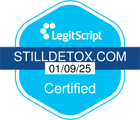Key Points
- Oxycodone is a generic, immediate-release opioid for short-term pain relief.
- OxyContin is a brand-name, extended-release oxycodone for long-lasting chronic pain management, with a higher dose.
- Both work by binding to opioid receptors, reducing pain and causing euphoria, leading to addiction potential.
- OxyContin contributed significantly to the opioid epidemic due to its high dose and misuse potential when altered.
- Key differences are release mechanism, use cases (acute vs. chronic pain), and dosage frequency (every 4-6 hrs vs. every 12 hrs).
- Both carry high addiction risk; OxyContin’s extended-release form poses greater danger if misused.
- They can be used together for different pain types but require careful monitoring for overdose.
- Seeking professional help is essential for managing opioid use, dependence, or misuse.
What is Oxycodone?
Oxycodone is a generic opioid prescribed to manage moderate to severe pain. It is commonly available in immediate-release forms, such as tablets or capsules, and provides short-term pain relief, typically lasting 4 to 6 hours. It may also be combined with other medications, like acetaminophen, to enhance its effectiveness.
What is OxyContin?
OxyContin is a brand-name, extended-release formulation of oxycodone that delivers the medication gradually over a 12-hour period. Manufactured by Purdue Pharma, it is prescribed primarily for chronic pain conditions requiring continuous, long-term pain management. Its design reduces the frequency of dosing but also contains a higher concentration of oxycodone, which makes misuse more dangerous.
How Does Oxycodone Work in the Body?
Oxycodone works by binding to specific opioid receptors in the brain and spinal cord, part of the central nervous system (CNS). These receptors, known as mu-opioid receptors, are responsible for transmitting pain signals. By activating these receptors, oxycodone reduces the perception of pain and induces a sense of relaxation or euphoria.
While this mechanism makes oxycodone highly effective for managing moderate to severe pain, it also contributes to its potential for misuse. The repeated stimulation of opioid receptors can lead to tolerance, where higher doses are needed to achieve the same effect, and dependence, where the body relies on the drug to function normally.
Oxycodone and OxyContin in the Context of the Opioid Epidemic
Oxycodone and OxyContin have played a significant role in the ongoing opioid epidemic, particularly in the United States. OxyContin, introduced in the mid-1990s, was initially marketed as a safer and less addictive option for managing chronic pain. However, its extended-release formula contains higher doses of oxycodone, which led to widespread misuse when the pills were crushed or altered to release the drug all at once.
Opioid overdose deaths involving oxycodone saw a sharp increase in the early 2000s, as highlighted by the National Institute on Drug Abuse (NIDA). While reformulating OxyContin in 2010 with abuse-deterrent properties reduced some risks, the widespread overprescription and misuse of these medications have left lasting challenges. These issues underscore the delicate balance required in managing pain effectively while minimizing the potential for addiction and overdose.
Key Differences Between Oxycodone and OxyContin
- Release Mechanism: Oxycodone is immediate-release, providing short-term pain relief, while OxyContin is extended-release, offering long-lasting pain relief.
- Use Cases: Oxycodone is often prescribed for acute pain, such as after surgery or injury, while OxyContin is designed for chronic pain management.
- Dosage Frequency: Oxycodone is typically taken every 4 to 6 hours as needed, whereas OxyContin is taken every 12 hours.
Risks of Addiction To Prescription Drugs
Both oxycodone and OxyContin carry a high risk of addiction, misuse, and dependence. OxyContin, in particular, has been linked to the opioid epidemic due to its extended-release nature, which contains higher doses of oxycodone. If misused—such as by crushing, chewing, or injecting—the controlled-release mechanism is bypassed, leading to a rapid and potentially lethal spike in oxycodone levels.
Dr. Andrew Kolodny, an addiction specialist, noted, “The misuse potential of OxyContin lies in its design; tampering with the pill can release a high dose of oxycodone all at once, increasing the risk of overdose.” Source: JAMA.
Can Oxycodone and OxyContin Be Used Together?
In certain cases, healthcare providers may prescribe both medications to address different types of pain. For example:
- OxyContin: Used as a baseline medication for chronic pain.
- Oxycodone IR: Prescribed for breakthrough pain that is not adequately controlled by OxyContin.
This approach requires close monitoring to avoid overdose and dependency risks.
When to Seek Help
If you or someone you know is using oxycodone or OxyContin and is concerned about dependence or misuse, seeking professional help is essential. Treatment options include medication-assisted therapy (MAT), counseling, and supervised detox programs.








